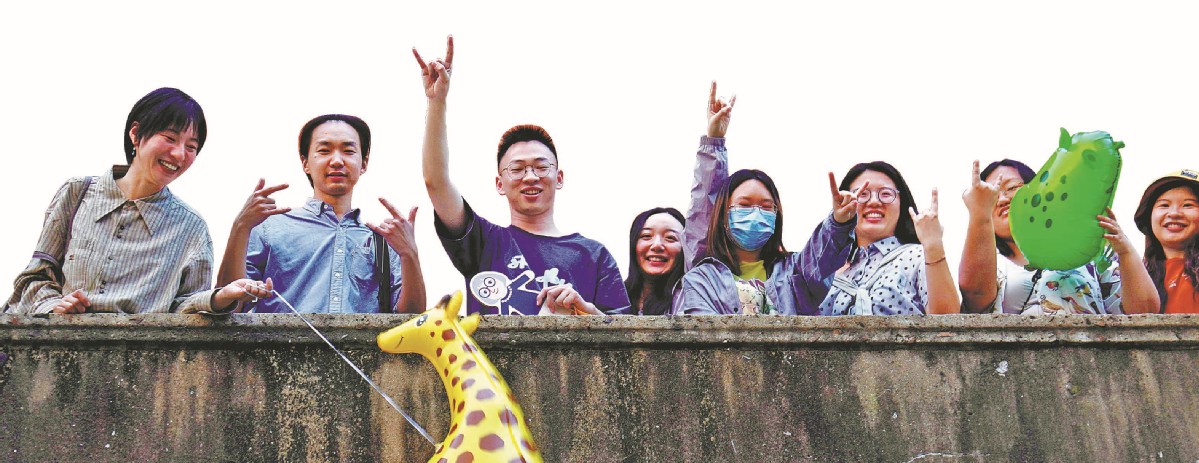

Organized cultural, historical tours finding favor with travelers, residents
For Fang Rui walking the streets of Nanjing, the capital of Jiangsu province, and taking in the buildings and culture of the historical city is almost a daily routine.
Born and raised in Nanjing, the 28-year-old works as a landscape designer in the city after studying overseas for several years. After she returned home she found that walking through the city, visiting and observing cultural and historical sites, gave her life new meaning.
In May, Fang organized a free city walk for around 50 people who came from all over the country to experience a deeper connection with Nanjing.
The city-walk pastime of following planned routes to explore a city's history, culture and urban environment originated in London. The pastime is now attracting a growing number of followers in China, with many young people taking part.
The scale of the trend is hard to measure, but widely shared social media posts document different routes in various metropolises with detailed descriptions and pictures.
On Xiaohongshu, a lifestyle-sharing platform, the hashtag "Holiday citywalk" has more than 470 million views.
Data from Tongcheng Travel, a travel agency based in Suzhou, Jiangsu province, shows that travel searches related to "city walk" increased by 108 percent in July from the previous month. Walking routes in Beijing, Xi'an, Shaanxi province, Chengdu, Sichuan province, Suzhou and Changsha, Hunan province, have attracted great interest from young travelers.
For tourists as well as locals not fully familiar with a city's history and culture, the organized walks are an authentic and immersive experience. Walk organizers provide the information and are passionate and care about a city's cultural heritage. They also have a more personalized and deeper understanding of their city, which goes beyond just visiting iconic landmarks.
Different to regimented travel, where people try to visit as many places as possible in the shortest amount of time, city walks allow people to linger and absorb the surroundings.
Bonding with city
Fang's organized walk in May through Nanjing's Qinhuai district renewed her bond with the city and helped the tour participants better understand its cultural heritage in a tangible and interesting way.
She chose to walk in Cinna Lane, or Xinan Li, a tourist area that is not as popular or famous as other Nanjing landmarks such as Fuzimiao Confucius Temple or Sun Yat-sen Mausoleum. The district has preserved various historical buildings, with the most well-known being the former residence of the scholar Gan Xi, which was built during the reign of the Qing Emperor Jiaqing (1796-1820). In terms of its grand scale and layout, it is believed to be the largest and most complete ancient residential building compound in China.
The walk began at 10:30 am on May 28 and lasted about 90 minutes, with Fang's group covering a distance of 3.91 kilometers. Two ancient sites in Pingshi Street, the main historical thoroughfare in Cinna Lane area, are worth exploring, she said.
One is the Daqiao Bridge located at the street's northern end, where writers and poets gathered in ancient times during Lantern Festival in the first lunar month.
The other is a Jiangxi Guild Hall, also known as a Wanshou Palace, on Pingshi Street, which was said to be built for the birthday celebration of Empress Dowager Cixi (1835-1908) during the Qing Dynasty (1644-1911).
During urban renewal, residents living in the old buildings along Pingshi Street were moved out, Fang said, but the historical structures were left standing. No. 89 residential building, constructed in the Republic of China era (1911-49) and located at the intersection of Pingshi Street and Pingzhang Alley, remains intact. Its weathered iron gate features an old-fashioned lion lock and symmetrical double doors are embedded in the horsehead wall. The features convey a feeling of stepping back in time.
"One of the aims of our city walks is to also let participants become witnesses to the transformation of the city itself," Fang said.
"They may propose their own ideas about the future urban development of a historical neighborhood," she said, adding this makes them feel part of the city and shows they care about the local community, the living environment and "the rapid process of urbanization".